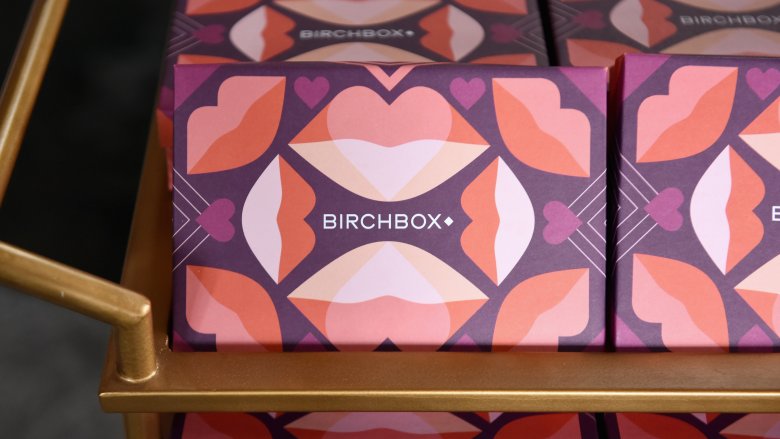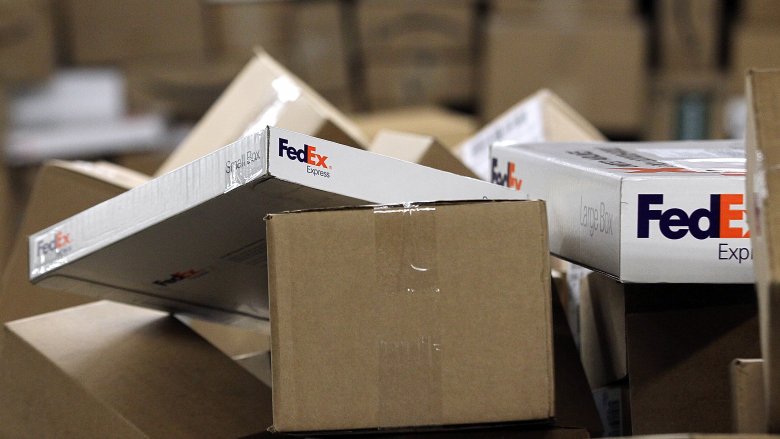The Untold Truth Of Subscription Boxes
Subscription boxes. Besides being the embodiment of all evil, these fun monthly packages bring joy, crap no one needs, and a monthly credit card charge that's impossible to cancel to millions of people all over the world. Once, subscription clubs were limited to a few generic offerings like books and CDs, but today, you can get a subscription box for just about anything, from makeup and craft supplies to organic snacks and complete meal kits. So what's the story behind the remarkable retail trend that started nearly a century ago and has somehow blossomed into a dark force that will soon swallow all of humanity in its merciless, demonic claws? Here it is, but beware. It may not be possible to resist the unnatural forces behind subscription box services and the advertising campaigns that suck you in like a helpless, doomed insect in the inescapable vortex of a flushing toilet. You have been warned.
Subscription boxes, brought to you by infrastructure and an act of Congress
It's really impossible to talk about how far subscription boxes have come without first noting how far the U.S. Postal Service has come. Way back in the Wild West, there was no rural mail delivery. So you either lived in an overcrowded city where you worked 18 hour days at the factory and most of your drinking water was mixed with someone else's poop, or you had to hitch up your horse and travel for hours to get to the big city, where you'd hopefully have some mail waiting for you. And if you didn't have any mail waiting for you, that would be super annoying.
Anyway, according to USPS, at some point it occurred to someone in the government that the vast majority of Americans — 65 percent at the time — did not live in cities, so maybe they should think about delivering mail to rural communities. In 1902, after a whole lot of arguing about cost and practicality, "rural free delivery" finally became a thing, and rural people no longer had to go into town to pick up their mail. With the new service came incentives to build roads and infrastructure, and life in America improved overall. Without these innovations, package delivery wouldn't be possible, and you would never know the joys of receiving of a box full of housewares, makeup, or those health products you were too embarrassed to buy in person at Walgreens.
The first real subscription box was launched nearly a century ago
It seems as though the subscription box craze has only been with us for a little while. Well, actually it seems like whole a lifetime of horror, but that's just perspective talking. At any rate, things really only started to get ridiculous in the last decade or so, but the subscription box as a business model is actually much, much older than that.
The Book of the Month Club was the first true subscription box — according to Tedium, the service was the brainchild of one Harry Scherman, a journalist and advertising pro who believed mail order was the best way to break into the literature-deficient rural book market. And to keep people buying, he hit on a genius idea: Instead of depending on customers to open up a catalog under their own volition and order a new item regularly, he could just charge them a monthly fee, send them some random book they might not even want, and depend on them to forget to cancel their subscription or put it off for an extra month because maybe the next delivery wouldn't suck as much. And so in 1926, the fundamental skeleton of the subscription box model we know today was born. Hooray.
And now, there's no end in sight. No end. In sight.
And then, in 2010, Birchbox. Now, there were others between the Book of the Month Club and Birchbox, like Columbia House Records and various wine-, cheese-, and coffee-of-the-month clubs, but until Birchbox started doing it the world was sort of meh about the idea. Then, Birchbox founders Katia Beauchamp and Hayley Barna were drinking Starbucks or something when it occurred to them that buying makeup was haaaaard. Why should women go to department stores and, you know, buy things they actually need when they can get boxes of stuff shipped to their doors every month, and then have to go to the department store anyway because the thing they needed wasn't actually in this month's box? Oh and also every woman should have an industrial-grade storage system to keep all the crap she gets in her subscription box. Anyway.
The Birchbox idea took off, partly because of the tenacity of its founders and partly because people realized that getting a box full of surprises in the mail was much, much more fun than knowing that some book you were only mildly curious about was going to arrive sometime next week. And because no profitable idea can exist in a vacuum, it wasn't long before subscription boxes for literally anything you have a passing interest in became available for you to sign up for and then forget to cancel. And the world changed forever.
So why? Just, why?
There are a number of theories about why this idea appeals to so many people. Forbes seems to think it's because it's no longer enough to just give customers what they want. That's right, that once bullet-proof, irrefutable idea that satisfied customers are happy customers is just wrong, wrong, wrong. No, to make modern customers happy, one must give them something they're not expecting.
Now, you will take note that the thing those customers aren't expecting doesn't necessarily have to fit into the simplistic model of "giving customers what they want" because it's impossible to please everyone with a surprise product. But it doesn't matter because subscription boxes aren't selling the product — they're selling the surprise. They're selling that Christmas morning moment where someone gives you a box and you don't know what's inside it. They're selling the thrill of discovery.
Companies do run the risk of completely missing the mark, though, just as you personally will always run the risk of missing the mark when you buy a surprise gift for a friend or family member. Which is why the most successful subscription companies tend to personalize their offerings — customers get makeup that's curated according to their skin tone and type, for example. So really it's not so much about pleasing the customer with the product as it is about not upsetting them too much when the initial surprise-high wears off and they realize they're stuck with the thing that came in the box.
That quirky little box is a small part of an enormous engine
What was once a cute, quaint idea for a fun product has ballooned into a massive, steampunk engine that rolls slowly across the retail landscape, consuming the paychecks of hapless consumers and spewing tubes of mascara out the other end. Forbes says in 2018, online visits to subscription box sites were ten times what they were just four years before that. Americans made 41.7 million visits to subscription websites in the month of April 2018 alone, and between 2013 and 2018 the market doubled each year. The biggest names in subscription box services generated $2.6 billion in sales during 2016, which was a huge increase over the piddly $57 million they collected in 2011.
So you can see why companies would be keen to jump on that bandwagon. And growth doesn't really seem to be slowing. But alas, it's not an easy marketplace to thrive in. One study found that the cancellation rate is as high as 40 percent, despite companies spending a lot of money on customer acquisition with offerings like free trials and deep discounts. So while the model is definitely something that appeals to consumers, companies still have to hammer out the details as far as making sure customers get the value they're expecting.
Come subscribe with us, Danny, forever and ever
All subscription box companies aren't created equal. Most of them are genuinely trying to please their customers — after all, a happy customer is a customer who doesn't cancel the subscription because the stuff they got this month is mostly okay and who knows, something really cool might come next month. And most of these companies do recognize that not everyone is going to love their service and they have to give customers a way out. Most of them.
Other companies have amassed thousands of complaints because they've put customer acquisition over product quality, and then made customer retention a matter of just making it impossible for their victims to escape, sort of like the Overlook Hotel in the offseason. In 2016, Business Insider reported that a subscription-based company called JustFab misled customers into signing up for a subscription with "fine print [that] was exceedingly difficult to discern." Consumers found surprise charges on their credit cards and then learned there was no way to cancel online — instead, they'd have to call customer service and presumably listen to some spiel about how they really, didn't want to cancel after all.
This wasn't just a couple people who weren't paying attention, either — there were hundreds of complaints against JustFab filed with the Better Business Bureau. And JustFab isn't alone in being super-sketchy — consumers should always be wary, check online reviews, and avoid any subscription services that seem at all questionable.
Oh you mean you were actually expecting to get that thing we said you'd get?
Here's another one — according to AlleyWatch, a subscription-based company called ELLIE misled customers into signing up by telling them that they planned to ship a monthly offering of name-brand workout apparel, but then not actually doing that. Instead they pulled a bait-and-switch, luring subscribers with promises of Nike, Under Armour, and Lululemon for a mere $39.99 a month, and then sending them a bunch of crap from their own dumb product line instead. To be fair, we really have no idea if the stuff from their product line was crap or not and they did warn their subscribers prior to actually sending them boxes full of stuff they didn't sign up for, but the point is their advertising was deceptive.
What's particularly insidious about the whole thing is that it worked: ELLIE got $2 million from venture capitalists and is still alive and well today despite being perhaps the most obnoxious company in the history of the internet. So crime doesn't pay, clearly, but lying to potential customers in the name of brand recognition sure does.
You, yourself, and your creepy, faceless best friend
Okay, so a subscription box is a fun surprise you get in the mail. On the surface, that sounds really great. But there's some pretty sad, underlying stuff, too, lurking in the psychological darkness. According to one psychologist, the subscription box is kind of like the creepy doppelganger of a tradition we've had for a long time — sending and receiving gifts in the mail, only, you know, to/from actual human loved ones.
A subscription box is a gift you give yourself, only it's curated by a bunch of people who don't know you. So instead of having real people send you surprises in the mail, some faceless, nameless company sends them instead. You're not cultivating a relationship with anyone except the company, which you're basically paying to be your friend. In a way, it's kind of like offering someone cash to come to your birthday party.
But it's even more insidious than that. If you're cultivating that gifting relationship with a company instead of with a real live person you care about, do you start to develop a weird sense of one-sided friendship with the invisible entity that sends you the box every month? And if you do, does that make it more difficult to sever the relationship when you finally figure out the box is full of stuff you don't really want? Probably, and if you think that's not part of the business model, well, that's cute.
It's like chocolate cake for the soul, and not in a good way
The process of opening a subscription box is kind of like eating chocolate cake two days into your diet. First, there's the anticipation, and the part where you've somehow convinced yourself you deserve a treat. Then there's that first delicious bite, followed by three minutes' and 750 calories' worth of unbridled joy, followed at last by an overwhelming sense of "I wish I hadn't done that." Which incidentally is why subscription boxes would rather give you a few small crappy items instead of one not-crappy thing because they recognize that your sense of joy is directly proportional to the number of items you receive rather than the quality of those items.
Even the Wall Street Journal agrees that the thrill wears off pretty quickly, and when it's over, you find yourself with a box of clutter that's probably not much use to you but which you won't throw away because you had to pay real actual money for it. And the final, particularly cunning part is that when viewed on a month-to-month basis, $10 or $20 or $30 doesn't seem like that much, so you may be lulled into complacency. After all, just because the box wasn't awesome this month doesn't mean it won't be awesome next month. And as long as it's just $25 a month and not $300 a year ... oh, wait.
Move over drugs and alcohol, there's a new addiction in town
If you're starting to wonder whether the brain hack that is the modern subscription box might actually mess some people up, it does. According to Psychology Today, some informal polling has suggested that the average subscription box consumer subscribes to not just one box, but somewhere between seven and 15 boxes a month. Even at the lowest price point — $10 for each box — that's a total monthly investment of $70 to $150, or $840 to a whopping $1,800 a year. But most boxes are more expensive than $10 (some are as much as $150 a month), so that's a pretty conservative estimate.
That's not even as bad as it gets — those with the worst subscription addictions admit to receiving 40 boxes or more, so they never have to suffer the horror of a day without a subscription box. Except Sundays, which they will generally spend watching Netflix with a pint of Ben and Jerry's.
So subscription boxes, much like gambling, can be an addiction, but it's okay. You can subscribe to a subscription box that's designed to support you through your addiction recovery, so there's hope. Sort of.
Surprise, some subscription boxes are really dumb
It's not all clothes and makeup and gluten-free snacks — you've probably heard people say that there's a subscription box for everything, and that's not very far from the truth. History buffs who have always wished someone would send reproductions of boring historical documents directly to their mailboxes can subscribe to "Letters from Dead People" for just $12.99 a month. Or, for those who prefer dead things that consist of actual organic matter, Skulls Unlimited promises to send a monthly box full of "skulls, teeth, baculum, claws, and other osteological items" for just $25 a month. For parents whose kids haven't yet totally destroyed the carpet with the homemade slime recipes they found on YouTube, $30 a month will buy a subscription to the Slime Box Club. Maybe that's one that kids sign up for using their parents' credit cards, or maybe it's aimed at people who already live in dirty houses.
No matter how sustainable that box is, it's totally not sustainable
If you're still not unsold on the idea of monthly subscription boxes, here's another thought. Some subscription boxes offer green, sustainable items, organic snacks, and other "natural" products that help consumers feel like they're making responsible choices. But buying those items via monthly subscription box is the opposite of green. UPS may have a "rolling laboratory" of 9,300 fuel-efficient vehicles, but that still leaves 109,700 gas-guzzling monsters that cover a lot of miles every day to deliver monthly boxes of makeup, slime, grass clippings from celebrity yards, or whatever other weird thing makes customers want to drop $24.99 a month.
According to DealNews, some subscription services do package their goods in recycled cardboard, but that's a small piece of the sustainability puzzle — plastic tubes, plastic wrap, that glossy discount card that promises a kickback if you'll only just irritate enough of your friends and family to get one of them to also sign up — those items are less sustainable, and even the items that are 100 percent recyclable actually have to be, you know, recycled for any of that to really matter. So really, what's happening is an increase in waste and air pollution in exchange for that 30-second high that consumers are looking for the moment they open up that box. Is it really worth it? Yeah, what the heck. Who needs Planet Earth when we can have a box of organic makeup instead?












